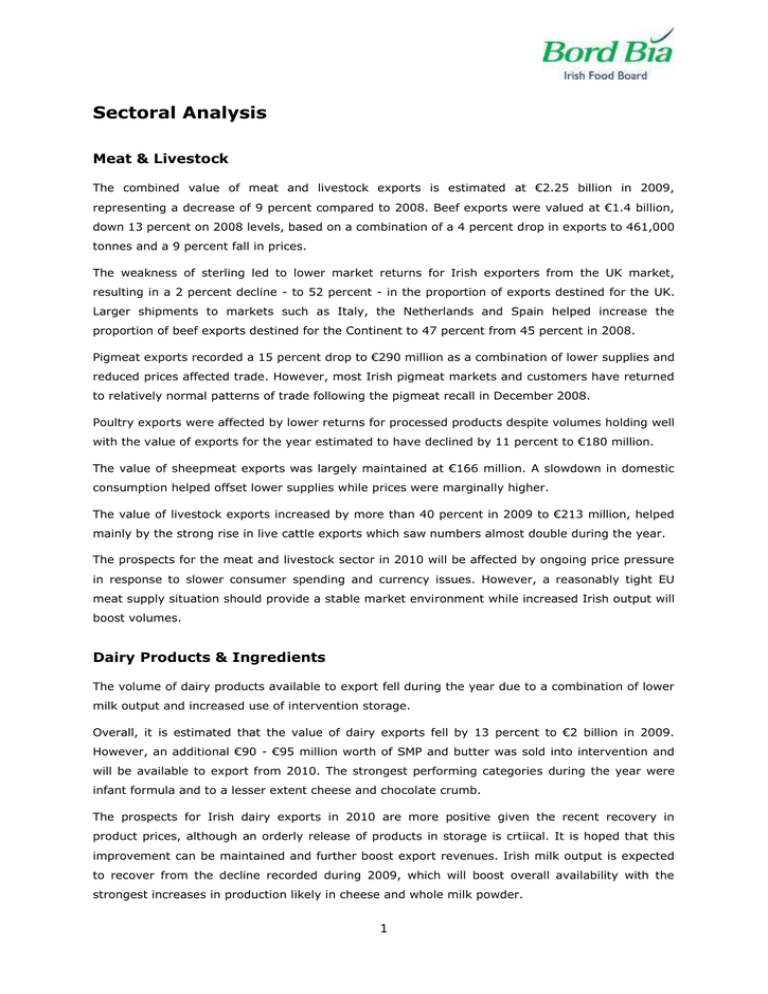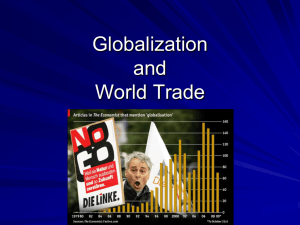Sectoral Analysis Meat & Livestock
advertisement

Sectoral Analysis Meat & Livestock The combined value of meat and livestock exports is estimated at €2.25 billion in 2009, representing a decrease of 9 percent compared to 2008. Beef exports were valued at €1.4 billion, down 13 percent on 2008 levels, based on a combination of a 4 percent drop in exports to 461,000 tonnes and a 9 percent fall in prices. The weakness of sterling led to lower market returns for Irish exporters from the UK market, resulting in a 2 percent decline - to 52 percent - in the proportion of exports destined for the UK. Larger shipments to markets such as Italy, the Netherlands and Spain helped increase the proportion of beef exports destined for the Continent to 47 percent from 45 percent in 2008. Pigmeat exports recorded a 15 percent drop to €290 million as a combination of lower supplies and reduced prices affected trade. However, most Irish pigmeat markets and customers have returned to relatively normal patterns of trade following the pigmeat recall in December 2008. Poultry exports were affected by lower returns for processed products despite volumes holding well with the value of exports for the year estimated to have declined by 11 percent to €180 million. The value of sheepmeat exports was largely maintained at €166 million. A slowdown in domestic consumption helped offset lower supplies while prices were marginally higher. The value of livestock exports increased by more than 40 percent in 2009 to €213 million, helped mainly by the strong rise in live cattle exports which saw numbers almost double during the year. The prospects for the meat and livestock sector in 2010 will be affected by ongoing price pressure in response to slower consumer spending and currency issues. However, a reasonably tight EU meat supply situation should provide a stable market environment while increased Irish output will boost volumes. Dairy Products & Ingredients The volume of dairy products available to export fell during the year due to a combination of lower milk output and increased use of intervention storage. Overall, it is estimated that the value of dairy exports fell by 13 percent to €2 billion in 2009. However, an additional €90 - €95 million worth of SMP and butter was sold into intervention and will be available to export from 2010. The strongest performing categories during the year were infant formula and to a lesser extent cheese and chocolate crumb. The prospects for Irish dairy exports in 2010 are more positive given the recent recovery in product prices, although an orderly release of products in storage is crtiical. It is hoped that this improvement can be maintained and further boost export revenues. Irish milk output is expected to recover from the decline recorded during 2009, which will boost overall availability with the strongest increases in production likely in cheese and whole milk powder. 1 Prepared Foods Exports of prepared foods faced a very difficult market environment during 2009. Given the backdrop, exports, particularly those from indigenous manufacturers, performed reasonably well. Overall, export values of product covered under the prepared foods category fell by an estimated 15 percent to €1.28 billion. Export values were helped by a relatively positive performance by both chocolate and sugar confectionery and bakery, which helped to partly offset a very challenging environment for ready meals and pizza manufacturers. The market environment for Irish prepared food exports in 2010 is expected to remain difficult, particularly if sterling remains weak over the coming months. Manufacturers are seeking to adapt products to the changed consumer shopping requirements while also seeking to diversify to a broader range of markets. Beverages Exports of beverages remained under pressure during 2009 as the impact of slower consumer spending and a fall off in the Travel Retail sector and supply chain destocking impacted on export revenues. All markets have also witnessed a noticeable shift toward value propositions. As with all other sectors beverages had to deal with the weakness of sterling but were also proportionately more exposed to the volatility in the US dollar than most categories. Overall, exports are estimated to have declined by 13 percent to almost €1.07 billion. The strongest performing category continued to be whiskey, which has dealt with the economic crisis better than most. Seafood The export market for Irish seafood was challenging in 2009 as weaker sterling led to reduced exports to the UK and led to strong competition in other key markets. Poorer weather in the final quarter of 2009 affected supplies but also helped unit prices. Overall, the value of seafood exports is estimated to have declined by 9 percent to €303 million. Edible Horticulture & Cereals The value of edible horticulture and cereal exports fell by 18 percent in 2009 to an estimated €218 million. Most of the decline was evident in cereal exports, which are estimated to have dropped by some 60 percent in response to lower prices and reduced volumes. Mushroom exports showed a marginal decrease as trade was increasingly affected as the year progressed by the weakness of sterling; however the outlook for mushroom exports looks firm once sterling stabilises. Substantial recent investments made by the Irish industry in compost production and mushroom production facilities would indicate that the industry shares this confidence. 2






